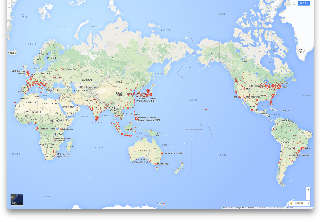It is said that there are over 20,000 MBA programs in the world. Which regions have the most? Searching for the keyword “MBA” in Google Maps yields some interesting results. Many shops and organizations use the abbreviation “MBA” in their names, so it must be noted that not all of the hits are directly related to MBA education. Nevertheless, rough trends can be seen.
First, in North America, it is clear that MBA programs are overwhelmingly distributed on the East Coast and in the Great Lakes region. In Europe, MBA programs are apparently clustered in the relatively temperate Mediterranean region. Both regions are at approximately 45°N latitude, at about the level of the city of Wakkanai in Hokkaido at Japan’s northern tip—cold regions, in other words; if you plan to study for an MBA abroad, take appropriate precautions. Business schools offer appropriate protection from the cold, often incorporating underground tunnels in their design and taking other measures, but cold is cold.
In addition to North America and Europe, MBA programs have experienced rapid growth in Asia over the past 20 years. Singapore and Hong Kong are the centers of this explosion, but in recent years, Shanghai, China, and Southern India have also seen increases in the number of MBA programs. I have visited over 30 business schools around the world, but it is very difficult to choose one among so many to recommend. Each school has its strengths and weaknesses in certain educational categories; none offers a “perfect” MBA program. For example, Italy offers many MBA programs that are useful in the elite fashion business, while the Netherlands offers numerous MBA programs that are useful in the oil industry. Many of Switzerland’s MBA programs offer strong business training, while the MBA programs in many U.S. schools are proficient at developing entrepreneurs.
This is where the yardstick of the Global MBA Rankings comes in. In brief, these rankings combine their own evaluations with those of business HR departments, university deans, and MBA graduates and rank these assessments by category or region. These rankings represent one method for weighing various programs’ pros and cons.

 Brochure
Brochure
 Info Session
Info Session
 Application
Application
 Alumni Voices
Alumni Voices






